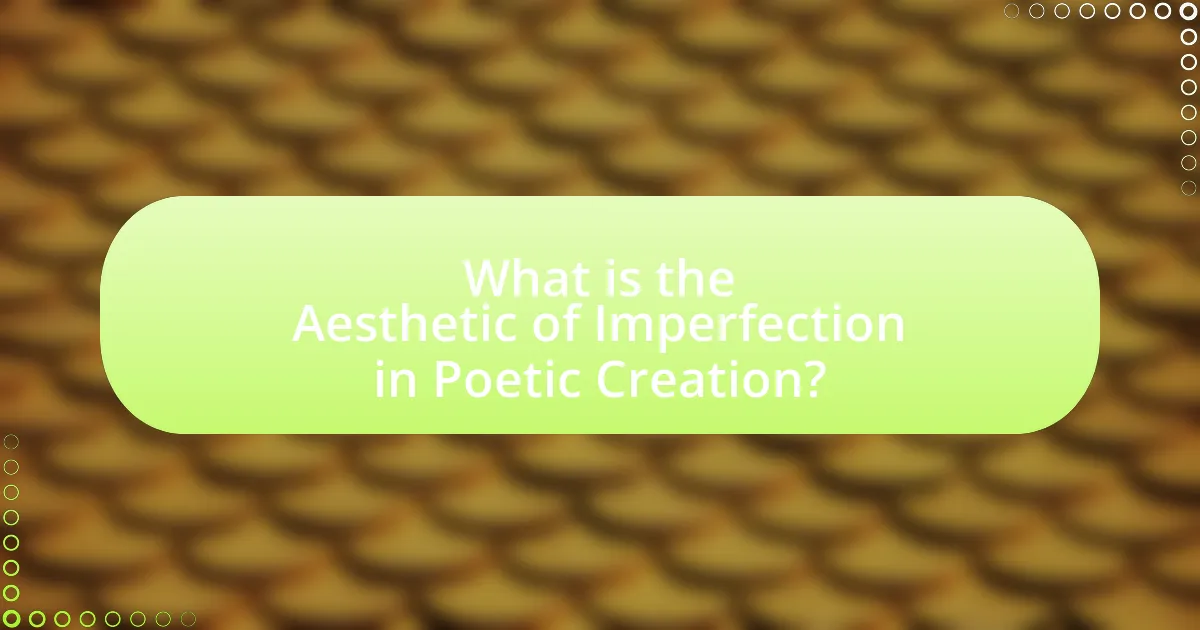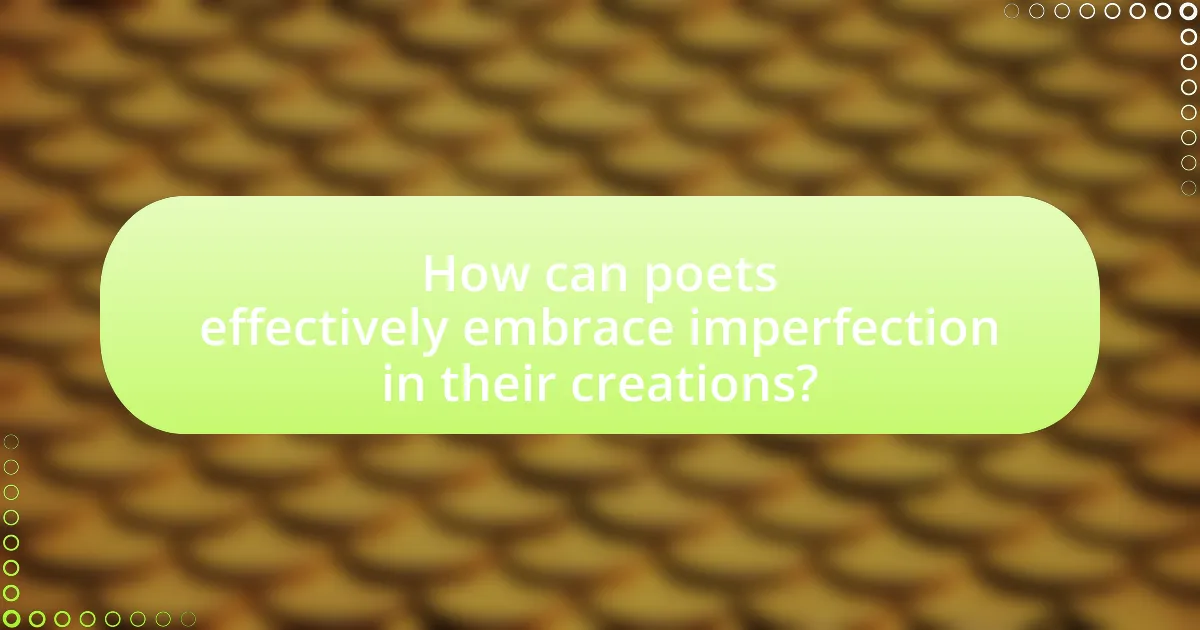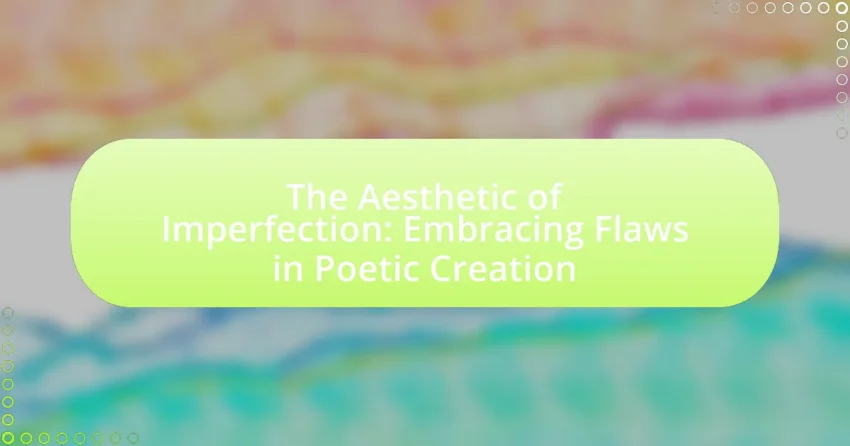The Aesthetic of Imperfection in Poetic Creation highlights the artistic value found in flaws and irregularities within poetry, emphasizing authenticity and the human experience. This concept is rooted in historical movements such as Romanticism and the Japanese philosophy of Wabi-Sabi, which celebrate vulnerability and the beauty of imperfections. The article explores how poets incorporate flaws through techniques like enjambment and irregular structures, and discusses the emotional responses these imperfections evoke in readers. Additionally, it examines the cultural influences on the perception of imperfection and offers practical strategies for poets to embrace flaws in their work, ultimately enhancing creativity and audience engagement.

What is the Aesthetic of Imperfection in Poetic Creation?
The Aesthetic of Imperfection in Poetic Creation refers to the artistic value found in flaws, irregularities, and unfinished elements within poetry. This aesthetic celebrates authenticity and the human experience, suggesting that imperfections can evoke deeper emotional responses and resonate more profoundly with readers. For instance, poets like John Keats and William Blake often embraced imperfections in their work, using them to convey raw emotion and personal truth, which enhances the relatability and depth of their poetry. This approach aligns with contemporary movements that prioritize vulnerability and authenticity, reinforcing the idea that beauty can emerge from imperfection.
How does the concept of imperfection manifest in poetry?
The concept of imperfection manifests in poetry through the use of flawed language, irregular structures, and raw emotions that reflect the human experience. Poets often embrace imperfections to convey authenticity and vulnerability, allowing readers to connect more deeply with the work. For instance, the use of enjambment or unconventional syntax can create a sense of disarray that mirrors the complexities of life. Additionally, poets like John Keats and Emily Dickinson have employed imperfect rhyme schemes and fragmented thoughts to evoke a sense of realism and emotional depth, demonstrating that beauty often lies in the flawed and the incomplete.
What are the historical roots of embracing flaws in poetry?
The historical roots of embracing flaws in poetry can be traced back to various literary movements that valued authenticity and the human experience over perfection. The Romantic movement in the late 18th and early 19th centuries, for instance, celebrated individual expression and emotional depth, often highlighting the beauty found in imperfection and vulnerability. Poets like John Keats and William Wordsworth emphasized the significance of personal experience and the natural world, which included acknowledging flaws as part of the human condition. Additionally, the Japanese aesthetic of Wabi-Sabi, which emerged in the 15th century, further influenced the appreciation of imperfection in art and poetry, promoting the idea that beauty lies in transience and the imperfect. This historical context illustrates how various cultural and literary traditions have shaped the acceptance of flaws in poetic creation.
How do cultural perspectives influence the aesthetic of imperfection?
Cultural perspectives significantly influence the aesthetic of imperfection by shaping how societies perceive and value flaws. For instance, in Japanese culture, the concept of “wabi-sabi” embraces the beauty of imperfection and transience, highlighting that flaws can enhance the emotional depth and authenticity of an object or artwork. This perspective contrasts with Western ideals that often prioritize perfection and uniformity, suggesting that cultural values dictate the appreciation of imperfections. Research indicates that cultures with a collectivist orientation, such as those in East Asia, tend to celebrate imperfections as reflections of human experience, while individualistic cultures may view them as shortcomings. Thus, cultural context plays a crucial role in defining the aesthetic value attributed to imperfections.
Why is embracing flaws significant in poetic expression?
Embracing flaws is significant in poetic expression because it enhances authenticity and relatability in the work. When poets acknowledge imperfections, they create a deeper emotional connection with readers, allowing them to see their own vulnerabilities reflected in the poetry. This approach aligns with the concept of wabi-sabi, a Japanese aesthetic that finds beauty in imperfection and transience, suggesting that flaws can evoke profound beauty and insight. By incorporating flaws, poets can challenge conventional standards of beauty and perfection, ultimately enriching the reader’s experience and understanding of the human condition.
What emotional responses does imperfection evoke in readers?
Imperfection evokes a range of emotional responses in readers, including empathy, nostalgia, and a sense of connection. Readers often feel empathy towards characters or situations that embody flaws, as these imperfections mirror their own human experiences. This emotional resonance can lead to a nostalgic reflection on personal struggles and vulnerabilities. Additionally, the acknowledgment of imperfection fosters a sense of connection between the reader and the text, as it highlights shared human experiences, making the narrative more relatable and impactful. Studies in psychology indicate that narratives featuring flawed characters can enhance emotional engagement, as they allow readers to explore complex emotions and foster a deeper understanding of the human condition.
How does imperfection contribute to authenticity in poetry?
Imperfection contributes to authenticity in poetry by allowing poets to express genuine emotions and experiences without the constraints of idealization. This rawness resonates with readers, as it reflects the complexities of human life, making the work relatable and impactful. For instance, poets like John Keats and Sylvia Plath often embraced their vulnerabilities and flaws, which added depth to their writing and connected them with audiences on a personal level. The acknowledgment of imperfection in poetic form and content fosters a sense of honesty, enhancing the overall emotional truth of the piece.

What are the key elements of the Aesthetic of Imperfection?
The key elements of the Aesthetic of Imperfection include authenticity, uniqueness, and the celebration of flaws. Authenticity emphasizes genuine expression, allowing artists to convey their true selves without the pressure of perfection. Uniqueness highlights the individuality of each piece, where irregularities and deviations from the norm are valued as distinctive traits. The celebration of flaws acknowledges that imperfections can evoke deeper emotional responses and resonate more profoundly with audiences. This aesthetic is rooted in various cultural movements, such as Wabi-Sabi in Japanese philosophy, which appreciates the beauty in transience and impermanence, reinforcing the idea that imperfection can enhance the overall experience of art and poetry.
How do poets incorporate flaws into their work?
Poets incorporate flaws into their work by intentionally highlighting imperfections to evoke authenticity and emotional resonance. This approach allows poets to connect with readers on a deeper level, as flaws often reflect the complexities of human experience. For example, the use of enjambment or irregular meter can create a sense of disarray that mirrors the unpredictability of life. Additionally, poets like John Keats and Sylvia Plath have utilized personal vulnerabilities and imperfections in their themes, demonstrating that embracing flaws can enhance the richness and relatability of their poetry. This technique aligns with the broader literary movement that values authenticity over idealization, reinforcing the idea that imperfections contribute to the overall aesthetic and emotional impact of poetic creation.
What techniques are used to highlight imperfections in poetry?
Techniques used to highlight imperfections in poetry include enjambment, irregular meter, and the use of colloquial language. Enjambment creates a sense of urgency and disrupts the flow, emphasizing the poem’s flaws. Irregular meter breaks traditional rhythmic patterns, drawing attention to the poem’s imperfections. Colloquial language introduces a conversational tone, making the imperfections more relatable and authentic. These techniques collectively enhance the aesthetic of imperfection, allowing poets to embrace flaws as integral to their creative expression.
How does language play a role in expressing imperfection?
Language serves as a crucial medium for expressing imperfection by allowing individuals to articulate flaws, vulnerabilities, and the nuances of human experience. Through the use of specific vocabulary, metaphors, and stylistic choices, language captures the essence of imperfection, enabling poets and writers to convey authenticity and relatability. For instance, the Japanese concept of “wabi-sabi” emphasizes beauty in imperfection, which can be reflected in poetic language that embraces asymmetry and transience. This approach not only highlights the inherent flaws in life but also fosters a deeper emotional connection with the audience, as it resonates with shared human experiences of struggle and resilience.
What themes are commonly associated with the Aesthetic of Imperfection?
Themes commonly associated with the Aesthetic of Imperfection include authenticity, vulnerability, and the beauty of flaws. Authenticity emphasizes the value of genuine expression, often celebrating the raw and unrefined aspects of art and life. Vulnerability highlights the strength found in exposing one’s imperfections, fostering deeper connections and empathy among individuals. The beauty of flaws suggests that irregularities and asymmetries can enhance aesthetic appeal, as seen in various art forms and cultural practices. These themes collectively challenge traditional notions of perfection, advocating for a more inclusive and realistic appreciation of creativity and existence.
How do themes of vulnerability and resilience appear in flawed poetry?
Themes of vulnerability and resilience prominently appear in flawed poetry through the expression of raw emotions and the acknowledgment of human imperfections. Flawed poetry often captures the speaker’s struggles, revealing their vulnerabilities, such as feelings of inadequacy or despair, which resonate with readers on a personal level. This emotional honesty fosters a sense of connection and empathy, illustrating the resilience that emerges from confronting and embracing these flaws. For instance, poets like John Keats and Sylvia Plath have utilized their personal struggles in their works, showcasing how vulnerability can lead to profound insights and strength. The interplay between these themes highlights the beauty found in imperfection, reinforcing the idea that resilience often arises from the very experiences that expose our vulnerabilities.
What role does nature play in the aesthetic of imperfection?
Nature serves as a fundamental source of inspiration for the aesthetic of imperfection by showcasing the beauty found in irregularities and asymmetries. Natural elements, such as weathered landscapes, gnarled trees, and uneven surfaces, exemplify how flaws contribute to a deeper appreciation of authenticity and uniqueness. This aesthetic is rooted in the concept of wabi-sabi, a Japanese philosophy that finds beauty in transience and imperfection, emphasizing that nature’s imperfections reflect the passage of time and the inherent cycle of life. Studies in art and design reveal that incorporating natural imperfections can evoke emotional responses, fostering a connection between the observer and the artwork. Thus, nature’s role in the aesthetic of imperfection is pivotal, as it not only inspires artistic expression but also encourages a broader acceptance of flaws as integral to beauty.

How can poets effectively embrace imperfection in their creations?
Poets can effectively embrace imperfection in their creations by intentionally incorporating raw emotions, unconventional structures, and spontaneous language. This approach allows poets to reflect authentic human experiences, which are often messy and flawed. For instance, the use of enjambment or fragmented lines can create a sense of urgency and vulnerability, mirroring the unpredictability of life. Additionally, poets like William Carlos Williams and e.e. cummings have demonstrated that breaking traditional forms can lead to innovative expressions that resonate deeply with readers. By valuing the beauty in flaws, poets can create works that are relatable and impactful, reinforcing the idea that imperfection is an essential aspect of the artistic process.
What practical strategies can poets use to incorporate flaws?
Poets can incorporate flaws by intentionally using irregular structures, embracing raw emotions, and employing vivid imagery that highlights imperfections. Irregular structures, such as varied line lengths or unconventional rhyme schemes, create a sense of authenticity and spontaneity, allowing the poet to reflect the chaotic nature of human experience. Embracing raw emotions enables poets to convey vulnerability, making their work relatable and impactful. Additionally, vivid imagery that focuses on imperfections, such as scars or broken objects, can evoke deeper connections with readers, illustrating the beauty found in flaws. These strategies align with the concept of the aesthetic of imperfection, which celebrates authenticity and the complexity of human existence.
How can poets shift their mindset to value imperfection?
Poets can shift their mindset to value imperfection by embracing the concept that flaws contribute to authenticity and emotional depth in their work. This perspective allows poets to see imperfections not as failures but as unique elements that enhance the richness of their poetry. Research in creative writing emphasizes that works perceived as imperfect often resonate more deeply with audiences, as they reflect genuine human experiences and emotions. For instance, the Japanese aesthetic of Wabi-Sabi celebrates the beauty found in impermanence and imperfection, illustrating how cultural frameworks can influence artistic expression. By adopting this mindset, poets can foster a more liberated creative process that prioritizes expression over perfection.
What exercises can help poets explore the aesthetic of imperfection?
Poets can explore the aesthetic of imperfection through exercises such as writing with constraints, embracing randomness, and revising with a focus on flaws. Writing with constraints, like using a specific form or limiting word choice, encourages creativity within boundaries, revealing the beauty in limitations. Embracing randomness, such as using found poetry or automatic writing, allows poets to discover unexpected connections and imperfections that can enhance their work. Additionally, revising with a focus on flaws, where poets intentionally highlight and celebrate imperfections in their drafts, fosters a deeper appreciation for the unique qualities that imperfections bring to poetry. These exercises collectively encourage poets to find value in the imperfect aspects of their creative process.
What common challenges do poets face when embracing imperfection?
Poets commonly face the challenge of self-doubt when embracing imperfection, as they often struggle with the fear that their work may not meet their own or others’ standards. This self-doubt can hinder creativity and lead to hesitation in sharing their work. Additionally, poets may encounter societal pressures that idealize perfection, making it difficult to accept flaws as part of the artistic process. The tension between personal expression and external expectations can create a conflict that complicates the acceptance of imperfection in their poetry.
How can poets overcome the fear of judgment regarding flaws?
Poets can overcome the fear of judgment regarding flaws by embracing vulnerability and viewing imperfections as integral to their artistic expression. This mindset shift allows poets to recognize that flaws can enhance authenticity and relatability in their work. Research indicates that artists who accept their imperfections often experience greater creative freedom and satisfaction, as seen in studies on self-acceptance and creativity published in the Journal of Creative Behavior. By reframing flaws as opportunities for growth and connection, poets can diminish the fear of external judgment and foster a more genuine creative process.
What are the pitfalls to avoid when exploring imperfection in poetry?
When exploring imperfection in poetry, one must avoid the pitfall of overemphasizing flaws to the detriment of meaning. This can lead to a lack of coherence, where the intended message becomes obscured by excessive focus on imperfections. Additionally, neglecting the balance between imperfection and artistic intent can result in work that feels careless rather than thoughtfully crafted. Historical examples, such as the works of poets like John Keats, illustrate that while embracing flaws can enhance emotional depth, it is crucial to maintain a clear artistic vision to ensure that the imperfections serve a purpose rather than detract from the overall impact.
What are the benefits of embracing imperfection in poetic creation?
Embracing imperfection in poetic creation fosters authenticity and emotional resonance. This approach allows poets to express genuine feelings and experiences, making their work relatable to readers. Research indicates that art reflecting vulnerability can enhance connection; for instance, studies show that audiences often respond more positively to works that reveal flaws or struggles, as they evoke empathy and understanding. Additionally, imperfection encourages creativity by freeing poets from the constraints of perfectionism, allowing for experimentation and innovation in their craft. This liberation can lead to unique and impactful poetic expressions that resonate deeply with audiences.
How does embracing flaws enhance creativity and innovation?
Embracing flaws enhances creativity and innovation by fostering a mindset that values experimentation and risk-taking. When individuals accept imperfections, they become more open to unconventional ideas and approaches, which can lead to unique solutions and artistic expressions. Research by the University of California, Berkeley, indicates that creative individuals often thrive in environments where mistakes are seen as opportunities for learning rather than failures. This perspective encourages a culture of innovation, as seen in companies like Google, which promotes a “fail fast” philosophy to drive creative breakthroughs.
What impact does the aesthetic of imperfection have on audience engagement?
The aesthetic of imperfection significantly enhances audience engagement by fostering authenticity and relatability. When creators embrace flaws, they resonate more deeply with audiences who often seek genuine connections rather than polished perfection. Research indicates that audiences are more likely to engage with content that reflects real-life imperfections, as it creates a sense of shared experience and emotional resonance. For instance, a study published in the Journal of Consumer Research found that products and artworks showcasing imperfections are perceived as more trustworthy and relatable, leading to increased audience interaction and loyalty. This connection is crucial in poetic creation, where the rawness of emotion often captivates and retains audience attention.
What tips can poets follow to successfully embrace the aesthetic of imperfection?
Poets can successfully embrace the aesthetic of imperfection by intentionally incorporating raw emotions and unrefined language into their work. This approach allows for authenticity, as seen in the works of poets like William Carlos Williams, who often used everyday language and imagery to convey deeper truths. Additionally, poets should experiment with form and structure, allowing for deviations from traditional patterns, which can create a sense of spontaneity and surprise. Embracing mistakes as part of the creative process, as demonstrated by the Beat poets, can also lead to innovative expressions. Finally, reflecting on personal vulnerabilities and experiences can enhance the emotional resonance of their poetry, making it relatable and impactful.
